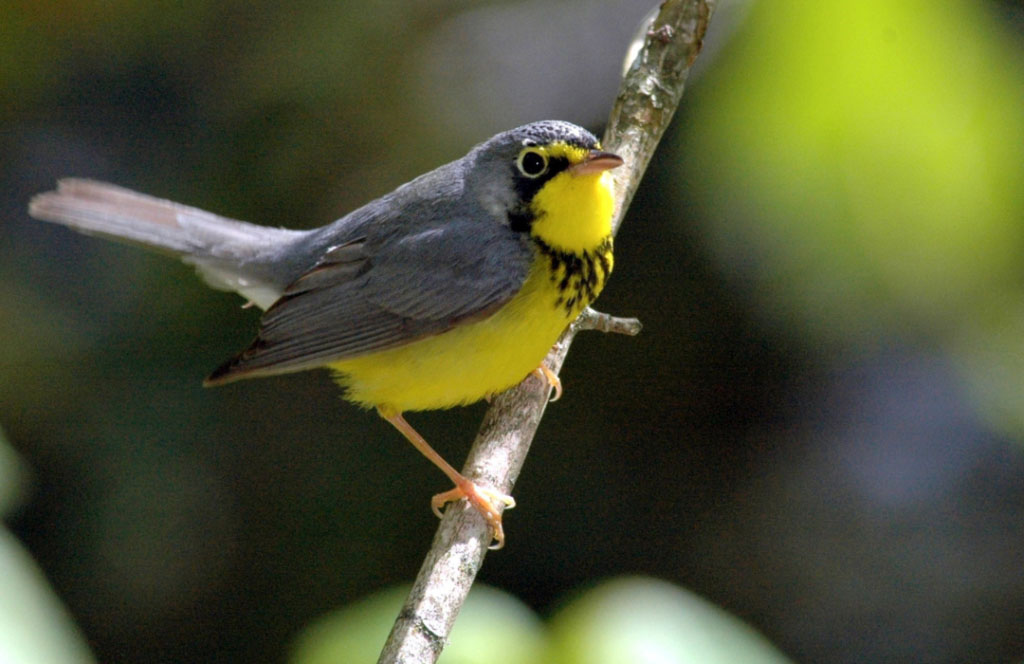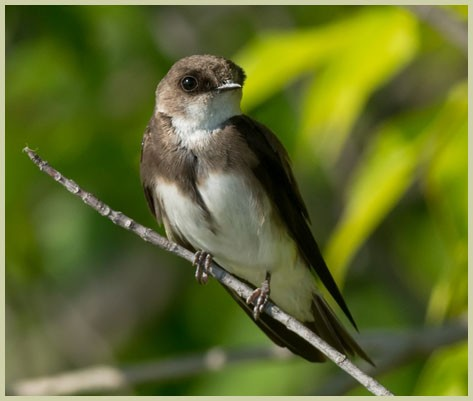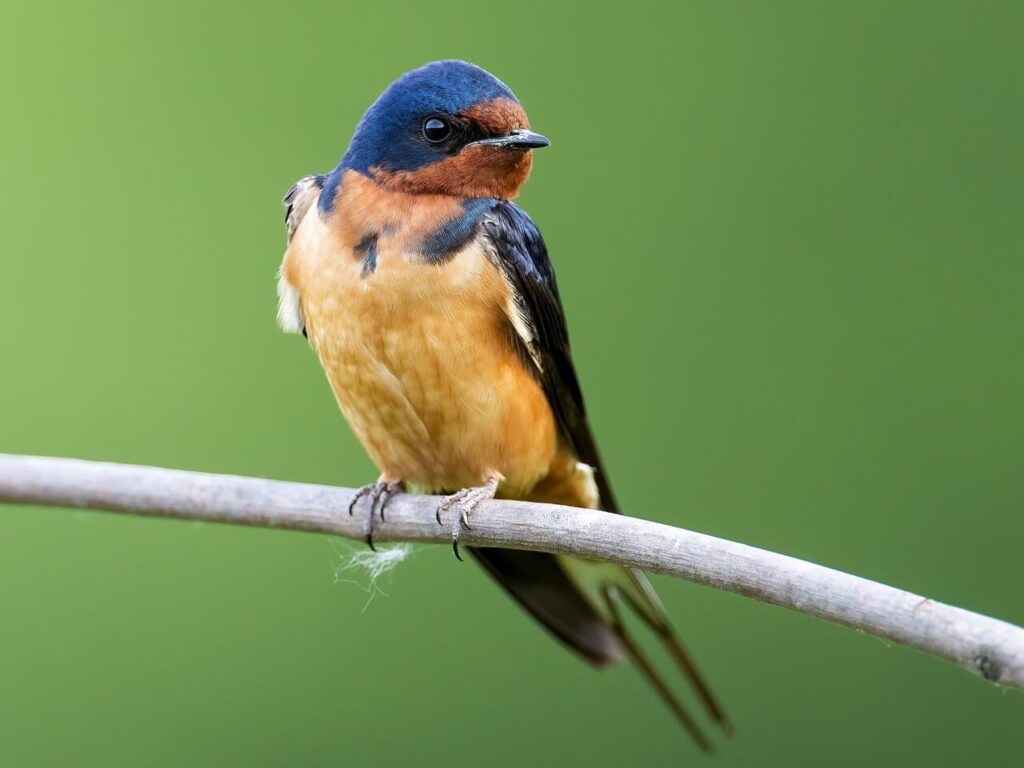Wildlife
Make a Donation
Join the Movement
Canada Warbler
- Common name: Canada Warbler
- Latin name: Cardellina canadensis
- Conservation Status: Special Concern
- Range: Yukon, Northwest Territories, British Columbia, Alberta, Saskatchewan, Manitoba, Ontario, Quebec, New Brunswick, Prince Edward Island, Nova Scotia
- Lifespan: Unknown, but the longest recorded age is 8 years
- Size: Wingspan of 17-22 cm, body length of 12-15 cm, weight of 9-13 g
Canada Warblers have blue-grey tails and backs, contrasted by bright yellow throats and breasts. Males and females also have black stripes on the top of their breasts, and just the males have black feathers on their foreheads and cheeks. Unlike most birds, these warblers keep the same plumage all year!
Threats
Protecting the Canada Warbler isn’t just Canada’s responsibility—it’s an international issue. The biggest threat to the Canada Warbler is deforestation, which affects it in Canada and South America. Approximately 90% of forest in the Andes, where the warbler spends the winter, have been cleared for things like agriculture and wood. Other impacts include some forestry practices, forest fragmentation, and climate change.
The Canada Warbler is also at high risk for colliding with buildings during migration.
What’s Being Done
The Canada Warbler International Conservation Initiative (CWICI) was established in 2013 at the BirdLife International Global Congress in Ottawa with Nature Canada, Bird Studies Canada, Environment Canada, and BirdLife International leading. Nature Canada established a website as a public face for the initiative.
In Canada, the warbler is protected under the Migratory Birds Convention Act (1994). Canada also has the Canada Warbler: Recovery Strategy 2016 in place, which focuses on stopping the decline of the species population, then increasing the population over time.
There is also the Canada Warbler Full-life-cycle Conservation Action Plan, the goal of which is to help populations of the warbler everywhere that it is found to live.
Canada has committed to the goal of protecting 30% of lands, ocean, and freshwater in Canada by 2030. This goal will help protect ecosystems, restore habitats, and fight climate change. All these things are a step in protecting Canada’s at-risk animals—so let’s hold the federal government to their promise.
Canada has committed to the goal of protecting 30% of lands, ocean, and freshwater in Canada by 2030.
This goal will help protect ecosystems, restore habitats, and fight climate change. All these things are a step in protecting Canada’s at-risk animals—so let’s hold the federal government to their promise.
Brown Myotis
The little brown bat or little brown myotis (Myotis lucifugus ) is an endangered species of mouse-eared microbat found in North America. It has a small body size and glossy brown fur. It is similar in appearance to several other mouse-eared bats, including the Indiana bat, northern long-eared bat, and Arizona myotis, to which it is closely related. Despite its name, the little brown bat is not closely related to the big brown bat, which belongs to a different genus.
Its mating system is polygynandrous, or promiscuous, and females give birth to one offspring annually. The offspring, called pups, are quickly weaned and reach adult size in some dimensions by three weeks old. The little brown bat has a mean lifespan of 6.5 years, though one individual in the wild reached 34 years old. It is nocturnal, foraging for its insect prey at night and roosting in hollow trees or buildings during the day, among less common roost types. It navigates and locates prey with echolocation.
It has few natural predators, but may be killed by raptors such as owls, as well as terrestrial predators such as raccoons. Other sources of mortality include diseases such as rabies and white-nose syndrome. White-nose syndrome has been a significant cause of mortality since 2006, killing over one million little brown bats by 2011. In the Northeastern United States, population loss has been extreme, with surveyed hibernacula (caves used for hibernation) averaging a population loss of 90%.
Humans frequently encounter the little brown bat due to its habit of roosting in buildings. Colonies in buildings are often considered pests because of the production of waste or the concern of rabies transmission. Little brown bats rarely test positive for rabies, however. Some people attempt to attract little brown bats to their property, but not their houses, by installing bat houses.
Appearance
The Little brown bat has small ears that do not reach the nose when pointing forward. The animal has blunt, medium-high tragus. The hind feet are large, covered with hairs, extending past the toes. Meanwhile, front and hind limbs have 5 metapodials. The glossy fur of the animal generally ranges in color from dark brown, golden brown and reddish to olive brown. However, there have also been known albino individuals among this species. The ventral side of the little brown bat is lighter. The animal has dark brown or black, almost hairless wing and interfemoral membranes. Males are smaller than females, which is most prominent during the winter months.
Habbits and Lifestyle
The Little brown bats are nocturnal. They typically enter torpor by day, appearing from their roosts at dusk. While at roosts, the bats are not territorial, living in large colonies of up to 300,000 individuals in one roost. These animals have two peak periods of activity: one takes place approximately 2 – 3 hours after dusk and the other occurs before down. They generally come back to their roosts at around 4 – 5 o’clock in the morning. During the winter months, they undergo hibernation, which varies in time, depending on location and altitude of a given roost. Usually, they enter hibernation between September and November, coming out between March and May. Meanwhile, young bats enter hibernation quite late, since they need to store fat, which will help them survive during the winter. In addition, pups do not travel long distances to hibernation roosts. The little brown bats travel not more than 100 miles.
GROUP NAME
cloud, colony
LIFESTYLE
Arboreal, Altricial, Torpor, Terrestrial,
SEASONAL BEHAVIOR
Hibernating, Not a migrant
Diet and Nutrition
The Little brown bats are insectivores, they feed upon a wide variety of insects, including hoppers, mosquitoes, midges, caddisflies, moths, small beetles and, occasionally, spiders.
Mating Habits
Little brown bats have polygynandrous mating system. They have two phases of mating, during which males mate with a number of females; the active phase, when both mates are awake and alert, and the passive phase, when active males mate with torpid bats of both sexes. They mate between September and October, while ovulation and fertilization takes place in spring. After 50-60 days of gestation, the female yields a single pup. The female is able to distinguish its offspring from other pups due to identifying call and odor. The baby is nursed by its mother, feeding exclusively upon maternal milk for the first 18 – 21 days and being weaned at the age of 3 weeks. Then, at about 4 weeks old, the pup begins to fly, becoming independent. Female bats first give birth within the first or second year of their lives.
Population Threats
Little brown bats are threatened with loss and fragmentation of their natural habitat as a result of deforestation. Presently, the animals suffer from a fungal disease known as “white-nose syndrome”. Cold and humid environment of their hibernaculas provides ideal conditions for fungus growth, which occasionally invades the bodies of hibernating bats, leading to debilitation and high numbers (up to 90%) of mortality. The animals are also exposed to human disturbance. Other notable concerns include use of pesticides and use of cyanide in mining.
Fun Facts for Kids
- During the winter, the animals undergo hibernation, enduring up to 50 degree Celsius change in temperature without any negative consequences.
- Little brown bats have three types of roosting sites: day roosts, which are typically located in caves, trees or under rocks; night roosts, found in the same places as day roosts, though separate in order to keep the feces in different places and thus protect the animals from predators; and finally, nursery roosts, which are larger than day roosts, occurring in large hollows or buildings.
- These bats are night hunters, eating a huge number of insects. An average bat will consume as many as 1000 insects, while a pregnant female will eat up to her whole body weight per sitting.
- In order to save energy, these animals sleep 20 hours a day on average.
- During the summer months, females rear the pups, living separately from males. By the approaching of winter, they reunite to mate and hibernate together. Because of food shortage, they usually leave their roosts, looking for larger hibernaculas.
- When cruising, these animals give out up to 20 calls per second in order to locate prey and objects.
References:
- Little Brown Bat Wikipedia article – https://en.wikipedia.org/wiki/Little_brown_bat
- Little Brown Bat on The IUCN Red List site – http://www.iucnredlist.org/details/14176/0
Bank Swallow
- The Bank Swallow is the smallest swallow in Canada.
- Both sexes are similar in appearance.
- Notice the brown band across their chest.
- Songs and calls: https://www.allaboutbirds.org/guide/Bank_Swallow/sounds
Status
The Bank Swallow is listed as threatened on Shedule 1 of the Federal Species at Risk ACT (SARA) since 2017.
It is also protected under the Migratory Birds Convention Act, 1994, which protects all individuals of the species as well as its nest and eggs on federal and non-federal lands.
In New Brunswick, the species was classified as “Endangered” in March 2021 under the provincial Species at Risk Act.
Distribution & Nesting Habbit
The Barn Swallow nests in Canada and the northern half of the United States.
Bank Swallow colonies are commonly found along the coastline of the Atlantic Provinces.
• Often in large colonies, Bank Swallows build their nest in vertical banks and bluffs in loose soils.
• Bank Swallows may also nest colonies in human-made habitats.
Federal Recovery Strategy
Bank Swallow population and distribution objectives:
- Maintain the current extent of occurrence
- In the short term (2021-2033)achieve a reduced rate of decline while ensuring that the populatin index remains above 80% of the 2021 level.
- In the long term (by 2053), achieve a stable 10 year trend while ensuring the population index remains above 90% of the 2021 level.
Some of the strategic directions for recovery:
- Raise awareness
- Identification of best management practices
- Protection of habitat on the breeding grounds and wetlands used as roosting habitat
- Reduce human disturbance around nesting colonies
- Restoration of lost or severely degraded wetlands especially in areas with nesting habitat
Barn Swallow
- The Barn Swallow is a medium-sized songbird that is easily recognized by its steely-blue upperparts, cinnamon underparts, chestnut throat and forehead, and by its deeply forked tail. Sexes have similar plumage, but males have longer outer tail-streamers than females and tend to be darker chestnut on their underparts.[Updated by COSEWIC – May. 2011].” [1]
- “Before European colonization of North America, Barn Swallows largely nested on fissures in cliffs, rock overhangs, and caves. Thereafter, their preferred nest sites became human-made structures, including barns, stables, houses, sheds, and bridges. Barn Swallows prefer to forage over open spaces such as grasslands, agricultural fields, shorelines, woodland clearings, wetlands, sand dunes, tundra, and roads. Barn Swallows nest in colonies or independently. They construct a small cup-shaped nest and affix it to a vertical, or occasionally a horizontal surface. ” [1]
- Songs and calls: https://www.allaboutbirds.org/guide/Barn_Swallow/sounds
Distribution & Nesting Habbit
“Barn Swallow is the most globally widespread species of swallow, occurring on every continent except Antarctica. In the western hemisphere, it breeds in Canada primarily south of the treeline, the United States and Mexico; Argentina also has a small breeding population. Barn Swallow has been documented breeding in every province and territory. Barn Swallow is a long-distance migrant, overwintering in the southern United States, parts of Mexico, and Central and South America.” [1]
References:
- Canada, G. (2022, January 14). Barn Swallow (Hirundo rustica): COSEWIC assessment and status report 2021 – Canada.ca. Government of Canada. Retrieved August 8, 2022, from https://www.canada.ca/en/environment-climate-change/services/species-risk-public-registry/cosewic-assessments-status-reports/barn-swallow-2021.html#toc6. [1]
- Species at Risk Public Registry. (2021b, February 2). Species at risk registry. Government of Canada. Retrieved August 8, 2022, from https://species-registry.canada.ca/index-en.html#/species/1147-790/ [2] https://www.iucnredlist.org/details/14176/0



